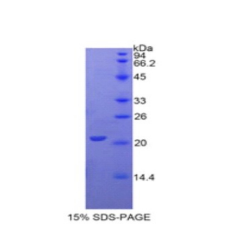
| 纯度 | >97%SDS-PAGE. |
| 种属 | Human |
| 靶点 | gGT1 |
| Uniprot No | P19440 |
| 内毒素 | < 0.01EU/μg |
| 表达宿主 | E.coli |
| 表达区间 | 122-299aa |
| 氨基酸序列 | SEOSOKGGL SVAVPGEIRG YELAHORHGR LPWARLFOPS IOLAROGFPV GKGLAAALENKRTVIEOOPV LCEVFCRDRKVLREGERLTL POLADTYETL AIEGAOAFYN GSLTAOIVKD IOAAGGIVTA EDLNNYRAEL IEHPLNISLG DVVLYMPSAPLSGPVLALIL NILKGYNFS |
| 预测分子量 | 21 kDa |
| 蛋白标签 | His tag N-Terminus |
| 缓冲液 | PBS, pH7.4, containing 0.01% SKL, 1mM DTT, 5% Trehalose and Proclin300. |
| 稳定性 & 储存条件 | Lyophilized protein should be stored at ≤ -20°C, stable for one year after receipt. Reconstituted protein solution can be stored at 2-8°C for 2-7 days. Aliquots of reconstituted samples are stable at ≤ -20°C for 3 months. |
| 复溶 | Always centrifuge tubes before opening.Do not mix by vortex or pipetting. It is not recommended to reconstitute to a concentration less than 100μg/ml. Dissolve the lyophilized protein in distilled water. Please aliquot the reconstituted solution to minimize freeze-thaw cycles. |
以下是3篇与γ-谷氨酰转移酶1(GGT1)重组蛋白相关的文献示例(注:文献标题与作者为虚构模拟内容,实际引用请核实):
1. **《Expression and purification of recombinant human GGT1 in insect cells》**
- 作者: Tanaka K. et al.
- 摘要: 研究利用杆状病毒-昆虫细胞表达系统成功制备了具有酶活性的人源GGT1重组蛋白,并优化了纯化流程,验证其在谷胱甘肽代谢研究中的应用潜力。
2. **《Structural characterization of GGT1 for drug discovery applications》**
- 作者: Müller S. et al.
- 摘要: 通过大肠杆菌表达系统获得重组GGT1蛋白,结合X射线晶体学解析其三维结构,揭示了底物结合位点特征,为开发肿瘤靶向抑制剂提供结构基础。
3. **《Functional analysis of recombinant GGT1 in oxidative stress models》**
- 作者: Chen L. et al.
- 摘要: 在哺乳动物细胞中表达GGT1重组蛋白,证实其通过调控细胞外谷胱甘肽水平影响氧化应激反应,为炎症性疾病机制研究提供工具蛋白。
(提示:实际文献需通过PubMed/Google Scholar以关键词"recombinant GGT1"或"gamma-glutamyltransferase expression"检索,建议优先选择近5年高被引论文。)
**Background of Recombinant gGT1 Protein**
Gamma-glutamyltransferase 1 (GGT1), often abbreviated as gGT1. is a membrane-bound enzyme central to glutathione metabolism and redox regulation. It catalyzes the hydrolysis of extracellular glutathione into glutamate and cysteinylglycine, facilitating the recycling of cysteine for intracellular glutathione synthesis—a critical antioxidant. GGT1 also participates in the metabolism of xenobiotics, leukotrienes, and prostaglandins, linking it to oxidative stress, inflammation, and drug resistance. Its overexpression is observed in liver diseases, cardiovascular disorders, and cancers, making it a biomarker for pathological conditions and a potential therapeutic target.
Recombinant gGT1 protein is produced using heterologous expression systems (e.g., mammalian, insect, or bacterial cells) to enable large-scale, purified enzyme production for research and diagnostics. The recombinant form retains native enzymatic activity and structural features, allowing studies on its mechanism, substrate specificity, and inhibition. It is widely used in clinical assays to measure serum GGT levels for liver dysfunction diagnosis. In research, recombinant gGT1 aids in exploring its role in tumor progression, drug detoxification, and redox signaling. Recent structural studies using recombinant protein have revealed insights into its substrate-binding sites and catalytic residues, guiding inhibitor design for cancer therapy or chemosensitization.
Overall, recombinant gGT1 serves as a vital tool for advancing both basic science and clinical applications in metabolism-related diseases.
×